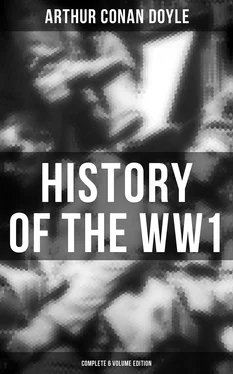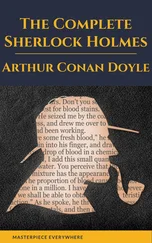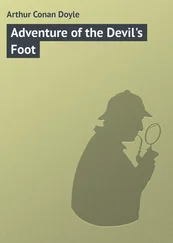The German Guard poured on into the woods which lay in the immediate rear of the British position, but their formation was broken and the individualism of the Briton began to tell. Next to MacMahon’ s regiment lay the 1st Scots Fusiliers, sister battalion to that which had been destroyed upon October 31. With fierce joy they poured volleys into the flank of the Guard as the grey figures rushed past them into the woods. Four hundred dead Germans were afterwards picked out from the underwood at this point. The Scots Fusiliers were also hard hit by the German fire.
At this period the Germans who had come through the line had skirted the south of a large wood of half-grown trees, called the Polygon Wood, and had advanced into the farther one, named Nonnebusch. At this point they were close to the British artillery, which they threatened to overwhelm. The 41st Brigade R.F.A., and especially the 16th Field Battery, were in the immediate line of their advance, and the gunners looking up saw the grey uniforms advancing amid the trees. Colonel Lushington, who commanded the artillery brigade, hurriedly formed up a firing line under his adjutant, composed partly of his own spare gunners and partly of a number of Engineers, reinforced by cooks, officers’ servants, and other odd hands who are to be found in the rear of the army, but seldom expect to find themselves in the van of the fight. It was a somewhat grotesque array, but it filled the gap and brought the advance to a halt, though the leading Germans were picked up afterwards within seventy yards of the guns. Whilst the position was critical at this point of the front, it was no less so upon the extreme right, where the French detachment, who still formed a Link between the canal on the south and the British right flank, were shelled out of their trenches and driven back. Lord Cavan’s 4th Brigade, their nearest neighbours, were too hard pressed to be able to help them. To the north of the Menin road a number of British units were intact, and these held up the German flood in that region. There are two considerable woods—the Polygon to the north and the Nonnebusch to the south-west of the Polygon—the edges of which have defined the British position, while their depths have harboured their artillery. Now the 1st King’s Liverpool Regiment held firm to the south of the Polygon Wood, while north of them were the 2nd Highland Light Infantry, with a field company of Engineers. Farther to the south-west were the 1st Connaught Rangers, while on the other side of the Nonnebusch road was the 7th Cavalry Brigade. In the afternoon of this day the enemy, skirting the south of the Polygon Wood, had actually entered the Nonnebusch Wood, in which it faced the artillery as already described. In the Polygon Wood, when they penetrated the trenches of the 1st Brigade, they had the Bang’s Liverpool Regiment on their right, which refused to move, so that for a long time the Prussian Guard and the King’s lay side by side with a traverse between them. “Our right is supported by the Prussian Guard,” said the humorous adjutant of the famous Lancashire regiment. While the main body of the Guard passed on, some remained all day in this trench.
The German Guardsmen had been prevented from submerging the 41st Brigade of Artillery, and also the 35th Heavy Battery, by the resistance of an improvised firing line. But a more substantial defence was at hand. The 2nd Oxford and Bucks Light Infantry, which had been in divisional reserve near Ypres, had been brought forward and found itself at Westhoek, near the threatened guns. This regiment is the old 52nd, of the Peninsular Light Division, a famous corps which threw itself upon the flank of Napoleon’s Guard at Waterloo and broke it in the crisis of the battle. Once again within a century an Imperial Guard was to recoil before its disciplined rush. Under Colonel Davies the regiment swept through the wood from north-west to south-east, driving the Germans, who had already been badly shaken by the artillery fire, in a headlong rout. Many threw down their arms. The loss to the Oxfords was surprisingly small, well under fifty in all. As they emerged from the wood they were joined by some of the 1st Northamptons from the 2nd Brigade upon the right, while on the left there was a rush of Connaughts and Highland Light Infantry from their own (Haking’s) brigade and of Engineers of the 25th Field Company, who showed extraordinary initiative and gallantry, pushing on rapidly, and losing all their officers save one and a number of their men without flinching for an instant. A party of the Gloucesters, too, charged with the Northamptons upon the right, for by this time units were badly mixed up, as will always happen in woodland fighting. “It was all a confused nightmare,” said one who tried to control it. The line of infantry dashed forward, a company of the Oxfords under Captain H. M. Dillon in the lead, and the khaki wave broke over a line of trenches which the Germans had taken, submerging all the occupants. There was another line in front, but as the victorious infantry pushed forward to this it was struck in the flank by a fire from French batteries, which had been unable to believe that so much progress could have been made in so short a time.
It was now nearly dark, and the troops were in the last stage of exhaustion. Of the 1st Brigade something less than 400 with 4 officers could be collected. It was impossible to do more than hold the line as it then existed. Two brave attempts were made in the darkness to win back the original front trenches, but it could not be done, for there were no men to do it. Save for one small comer of the Polygon Wood, the Germans had been completely cleared out from the main position. At twelve and at four, during the night, the British made a forward movement to regain the advanced trenches, but in each case the advance could make no progress. At the very beginning of the second attempt General FitzClarence, commanding the 1st Brigade, was killed, and the movement fizzled out. Besides General FitzClarence, the Army sustained a severe loss in General Shaw of the 9th Brigade, who was struck by a shell splinter, though happily the wound was not mortal. The German losses were exceedingly severe: 700 of their dead were picked up within a single section of the British line, but the main loss was probably sustained in the advance before they reached the trenches. Killed, wounded, and prisoners, their casualties cannot have been less than 10,000 men. 1
It was a fine attack, bravely delivered by fresh troops against weary men, but it showed the German leaders once for all that it was impossible to force a passage through the lines. The Emperor’s Guard, driven on by the Emperor’s own personal impetus, had recoiled broken, even as the Guard of a greater Emperor had done a century before from the indomitable resistance of the British infantry. The constant fighting had reduced British brigades to the strength of battalions, battalions to companies, and companies to weak platoons, but the position was still held. They had, it is true, lost about five hundred yards of ground in the battle, but a shorter line was at once dug, organised, and manned. The barrier to Ypres was as strong as ever.
The strain upon the men, however, had been terrific. “Bearded, unwashed, sometimes plagued with vermin, the few who remained in the front line were a terrible crew,” says the American, Coleman. “They were like fierce, wild beasts,” says another observer. They had given their all, almost to their humanity, to save Britain. May the day never come when Britain will refuse to save them.
Glancing for a moment down the line to the south, there had been continuous confused contention during this time, but no great attack such as distinguished the operations in the north. Upon November 7 two brisk assaults were made by the Germans in the Armentières area, one upon the Fourth Division of the Third Corps and the other upon the Seaforth Highlanders, who were brigaded with the Indians. In each case the first German rush carried some trenches, and in each the swift return of the British regained them. There were moderate losses upon both sides. On the same date the 13th Infantry Brigade lost the services of Colonel Martyn of the 1st West Kents, who was seriously wounded the very day after he had been appointed to a brigade.
Читать дальше












